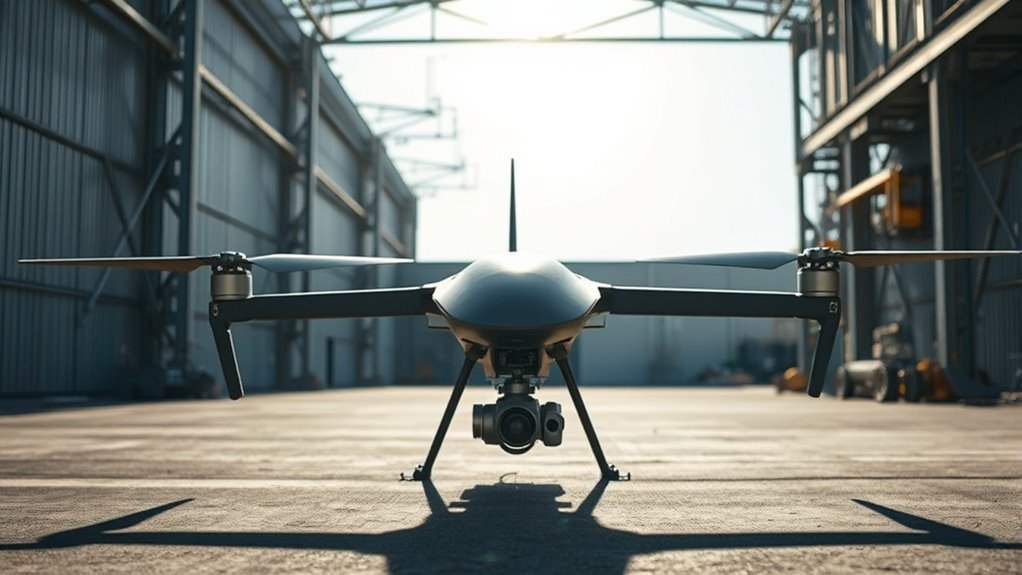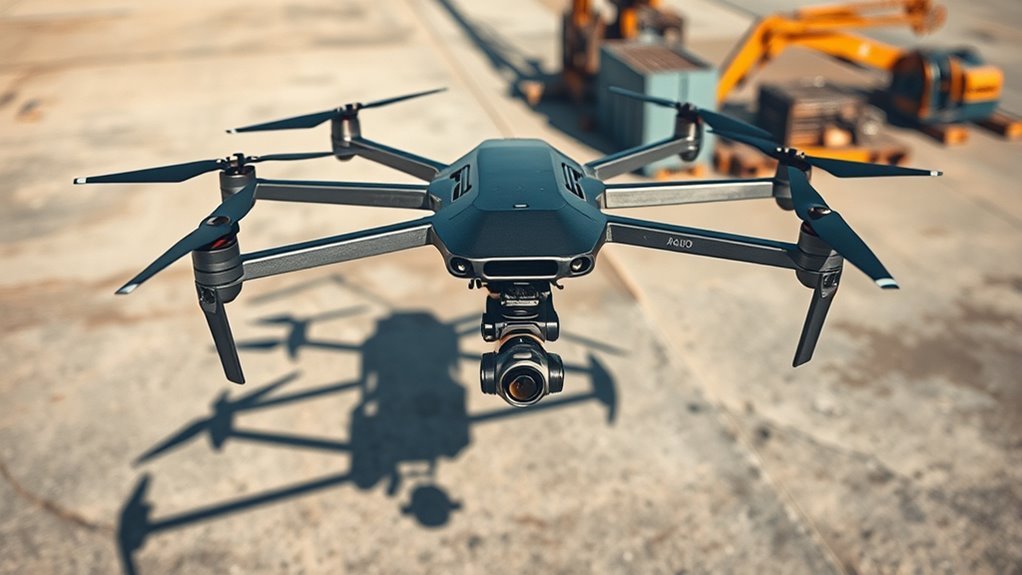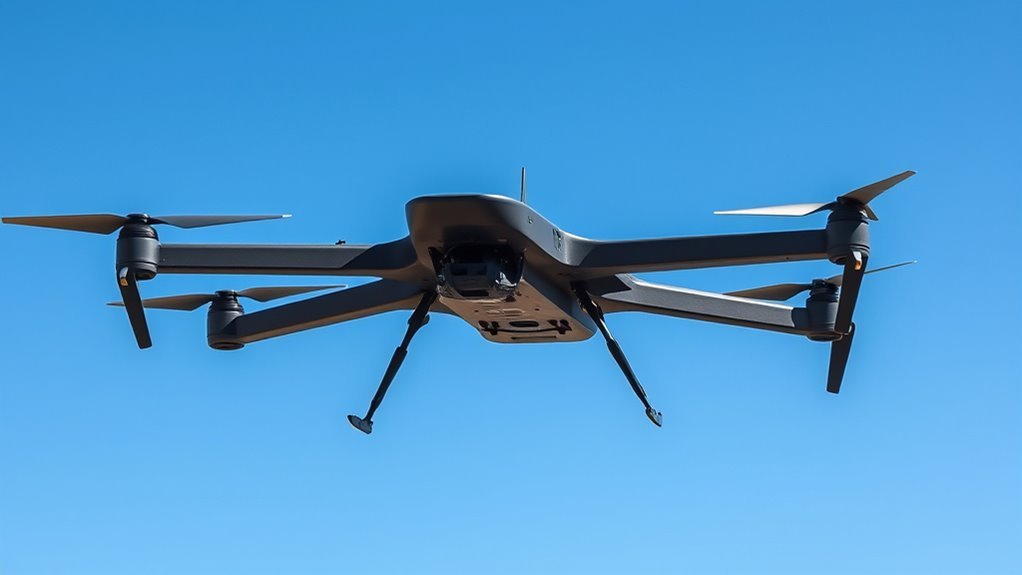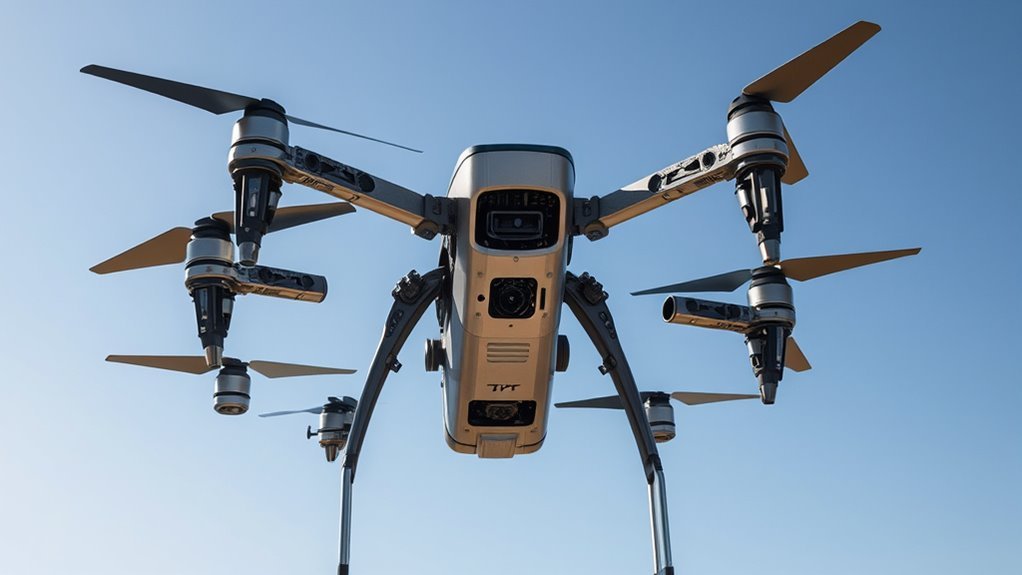Disassembly drones typically range in height from 0.5 to 1.5 meters, depending on their application. Compact models excel in tight spaces, while larger drones are suited for industrial tasks. The design considerations affect not only the size but also the drone’s efficiency and maneuverability. Additionally, larger drones can handle heavier payloads, enhancing their capabilities. Understanding these dimensions is key to optimizing drone performance, and further exploration reveals more insights into their functionalities and future trends.
Overview of Disassembly Drones

Disassembly drones, which are increasingly utilized in various industries, represent a significant advancement in automated deconstruction processes. These drones leverage cutting-edge drone technology to efficiently execute the disassembly process, reducing labor costs and time. By employing precision engineering, they navigate complex environments, dismantling structures with minimal human intervention. You’ll find that these drones can adapt to various materials, ensuring a versatile approach to deconstruction. Their ability to gather data in real-time enhances decision-making, allowing for smarter, safer operations. As you explore the potential of disassembly drones, consider how this technology can liberate your workflow, granting you the freedom to focus on higher-level tasks while ensuring efficiency and safety in the disassembly process. Embrace the future of automated deconstruction.
Key Features That Influence Dimensions

The dimensions of disassembly drones are influenced by several key features that enhance their operational efficiency and adaptability. One critical aspect is drone efficiency, which dictates how effectively the drone can perform its tasks without unnecessary weight or bulk. Streamlined designs minimize drag, allowing for quicker maneuverability. The choice of design materials also plays a significant role; lightweight yet durable materials can reduce overall size while maintaining structural integrity. Advanced technologies, such as foldable arms or retractable components, can further optimize dimensions without compromising functionality. Additionally, the intended application influences dimensions; drones designed for tight spaces require compact designs, while those meant for larger-scale disassembly may adopt more extensive structures. Ultimately, these factors converge to create efficient and purpose-driven disassembly drones. Furthermore, incorporating NDAA compliance into the design can enhance the drone’s adaptability for sensitive applications and regulatory environments. The use of high-quality materials can significantly improve the drone’s durability and performance during disassembly tasks.
Standard Height Measurements

When evaluating standard height measurements for disassembly drones, you’ll encounter typical height specifications that serve as benchmarks. However, variability in designs can lead to significant deviations from these norms, impacting both functionality and performance. Understanding these factors is essential for optimizing drone selection and application.
Typical Height Specifications
Many disassembly drones typically range in height from about 30 to 50 centimeters, depending on their design and intended functionality. These height specifications are vital, as they directly influence the drone’s maneuverability and effectiveness in various environments. Height limitations are often dictated by design standards that prioritize efficiency and structural integrity. For instance, a drone designed for tight spaces may lean towards the lower end of this spectrum, while those intended for broader applications might adopt a taller profile. Understanding these specifications helps you assess the suitability of a drone for your specific needs, ensuring that you make informed decisions based on operational requirements and design constraints. Ultimately, these dimensions contribute to the overall performance and versatility of disassembly drones.
Variability in Designs
Variability in designs of disassembly drones often leads to significant differences in standard height measurements. This design flexibility allows for various applications and operational environments, which can influence your material choices. Here’s a breakdown of common height specifications:
| Design Type | Height (cm) | Material Used |
|---|---|---|
| Standard Model | 150 | Carbon Fiber |
| Compact Model | 120 | Aluminum Alloy |
| Heavy-Duty Model | 180 | Reinforced Plastic |
Understanding these variations helps you select the right drone for your needs. Each height measurement serves distinct operational requirements, showcasing how design flexibility and material choices impact overall functionality. As you explore options, keep in mind how these factors can optimize performance and efficiency in disassembly tasks.
Variations in Size for Different Applications
When considering disassembly drones, size variations are essential for specific applications. Industrial models typically feature larger dimensions to handle heavier materials, while residential drones are designed to be more compact for ease of use in smaller environments. Additionally, specialized applications may require unique size adjustments to optimize performance and efficiency.
Industrial Disassembly Drone Size
The size of industrial disassembly drones is critically tailored to meet the specific demands of various applications. For instance, in large-scale manufacturing settings, you’ll find drones designed for heavy-duty tasks, often measuring over 1.5 meters in height to enhance reach and payload capacity. Conversely, in smaller facilities, compact drones, around 0.8 meters tall, maximize maneuverability without sacrificing drone efficiency. These variations allow for specialized adaptations, ensuring optimal performance across diverse industrial applications. By customizing dimensions, you can greatly improve operational efficiency, reducing time and resources spent on disassembly tasks. Ultimately, the right size not only aligns with specific operational needs but also empowers you to explore new possibilities in industrial disassembly, granting you the freedom to innovate in your processes.
Residential Use Dimensions
Residential disassembly drones come in a range of sizes, typically between 0.5 to 1.2 meters tall, to cater to the unique needs of home environments. These drone dimensions are tailored for various residential applications, ensuring efficiency and ease of use. Here are three key dimensions to evaluate:
- Compact Models (0.5-0.7 meters): Ideal for tight spaces, perfect for small apartments or intricate disassembly tasks.
- Standard Models (0.8-1.0 meters): Balances versatility and capability, suitable for most home uses.
- Extended Models (1.1-1.2 meters): Best for larger projects or areas with more significant debris.
Specialized Application Variations
Drones designed for specialized applications often deviate from standard residential dimensions to meet specific operational requirements. These drone variations can range considerably in size and configuration, tailored for tasks like agricultural monitoring or hazardous material handling. For instance, agricultural drones may be larger to accommodate advanced sensors and payloads, while drones used in confined spaces, like urban search and rescue, are typically more compact and agile. This adaptability guarantees that each drone meets its unique demands, optimizing performance and efficiency. Understanding these specialized applications allows you to appreciate how size impacts functionality. Whether you’re looking for precision in agriculture or maneuverability in urban settings, recognizing the diversity in drone dimensions is essential for selecting the right tool for your needs.
Impact of Drone Size on Performance
Although various factors influence a drone’s performance, size plays an essential role in determining its efficiency and capability. When considering size optimization, keep in mind the following performance factors:
- Maneuverability: Smaller drones can navigate tight spaces, making them ideal for intricate disassembly tasks.
- Payload Capacity: Larger drones typically carry heavier loads, enhancing their utility in extensive operations.
- Flight Time: Size affects battery efficiency; larger drones may consume more power, impacting their operational range.
Additionally, understanding signal attenuation is crucial for optimizing drone performance, especially when operating in environments with physical barriers.
Balancing these factors is fundamental for maximizing a drone’s potential. A well-optimized size not only enhances performance but also aligns with your specific operational needs, providing the freedom to tackle diverse challenges in disassembly.
Weight Considerations for Disassembly Drones
When considering the design of disassembly drones, weight plays a significant role in overall performance and functionality. Proper weight distribution is essential; it affects stability, maneuverability, and energy efficiency. A drone that’s too heavy may struggle to achieve its intended altitude or speed, while an underweight design may compromise structural integrity. You’ll need to balance the materials used with the drone’s payload capacity, ensuring it can effectively carry tools and components necessary for disassembly tasks. Additionally, optimizing weight can enhance battery life, allowing for longer operational periods. Ultimately, achieving the ideal weight is about marrying performance with capability, enabling your disassembly drone to operate effectively in various environments while maintaining agility and resilience.
Design Trends in Disassembly Drone Technology
As the field of disassembly drone technology evolves, several design trends are emerging that prioritize efficiency and adaptability. You’ll find that the latest advancements reflect a commitment to maximizing performance while reducing environmental impact. Key trends include:
- Innovative Materials: Lightweight and durable composites are becoming standard, enhancing mobility and resilience.
- Modular Designs: Drones are increasingly designed with interchangeable parts, allowing for quick upgrades and repairs, which extends their lifespan.
- Autonomous Systems: Enhanced AI algorithms are enabling drones to operate independently, optimizing disassembly processes in real-time.
These trends not only elevate functionality but also support sustainability goals, granting you the freedom to utilize disassembly drones in diverse applications without compromising on efficiency.
Case Studies: Size in Action
While the design trends in disassembly drone technology are essential, real-world applications highlight the importance of size in optimizing performance. For instance, take the case of a compact drone engineered for urban environments. Its smaller dimensions allow for agile navigation through tight spaces, demonstrating how size directly impacts operational efficiency. Conversely, larger drones used in industrial sectors showcase design innovations that enable them to handle heavy components, emphasizing the need for a balance between scale and functionality. Each case illustrates that the dimensions of disassembly drones are not just a matter of aesthetics; they play a critical role in their effectiveness. By examining these real-world applications, you can appreciate how size influences both capability and adaptability in diverse scenarios.
Future Developments in Drone Dimensions
The exploration of case studies reveals how size impacts drone performance, setting the stage for future developments in drone dimensions. As we look ahead, consider these three key areas for future innovations in drone design evolution:
The impact of size on drone performance paves the way for innovative advancements in design and functionality.
- Scalability: Adapting dimensions to optimize payload capacity while maintaining maneuverability will enhance operational efficiency.
- Modularity: Future drones may feature interchangeable components, allowing for tailored sizes based on specific missions without sacrificing performance.
- Aerodynamics: Innovations in shape and material will reduce drag and improve energy efficiency, leading to longer flight times. Additionally, advancements in sensor size technology will be crucial for enhancing image quality and low-light performance in future drone designs.
Frequently Asked Questions
How Do Disassembly Drones Compare in Size to Traditional Drones?
Disassembly drones typically prioritize disassembly efficiency over portability, making them bulkier than traditional drones. While traditional drones emphasize lightweight designs for maneuverability, disassembly drones require added dimensions to accommodate specialized tools and components for effective operation.
What Materials Affect the Size of Disassembly Drones?
When you consider a disassembly drone, think of a sculptor selecting materials; each choice influences its form. Material selection and weight considerations dictate size, balancing efficiency with functionality, ultimately shaping the freedom of movement and task performance.
Are There Specific Height Regulations for Disassembly Drones?
Yes, there’re height restrictions for disassembly drones. You must ascertain regulatory compliance, as these regulations vary by region. Staying informed helps you navigate legal boundaries while maximizing the drone’s operational capabilities and efficiency effectively.
Can Disassembly Drones Be Customized for Larger Dimensions?
Yes, disassembly drones can be customized for larger dimensions, but size limitations may apply based on specific regulations and design constraints. Exploring various customization options guarantees peak performance while adhering to necessary operational guidelines.
What Safety Features Are Influenced by Drone Size?
In a hypothetical scenario, a larger drone might include enhanced safety mechanisms like collision avoidance systems. However, size limitations can restrict sensor effectiveness, complicating safety measures and potentially increasing operational risks for users like you.

